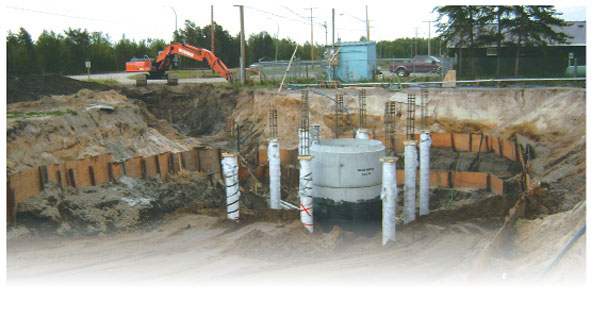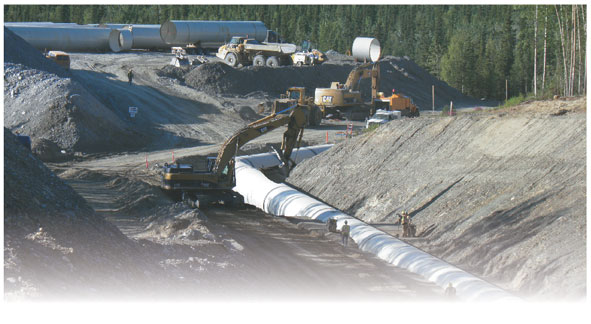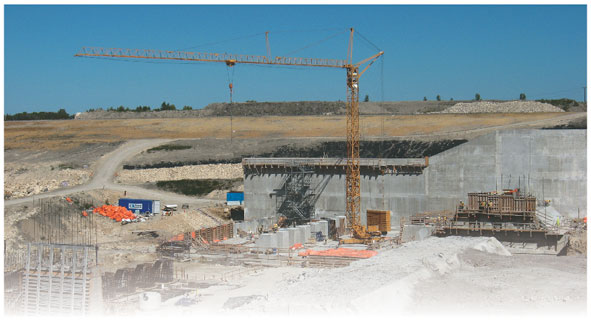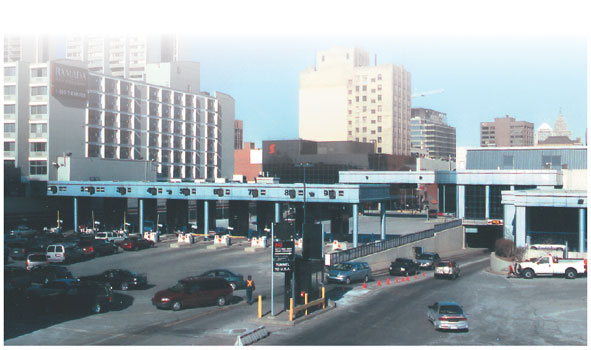Common menu bar links
Breadcrumb Trail
ARCHIVED - Infrastructure Canada - Report
 This page has been archived.
This page has been archived.
Archived Content
Information identified as archived on the Web is for reference, research or recordkeeping purposes. It has not been altered or updated after the date of archiving. Web pages that are archived on the Web are not subject to the Government of Canada Web Standards. As per the Communications Policy of the Government of Canada, you can request alternate formats on the "Contact Us" page.
Section II: Analysis of Program Activities by Strategic Outcome
2.1 Strategic Outcome 1
Provinces, territories and municipalities have federal financial support for their infrastructure priorities.
2.1.1 Program Activity: Provincial-Territorial Infrastructure Base Fund
Predictable Funding for Provinces and Territories
Program Activity Description:
This program activity provides $175 million in base funding to each province and territory for core infrastructure priorities. In addition, over $26 million in per capita funding under the Building Canada Fund for the three territories is managed under this fund. The Provincial-Territorial Infrastructure Base Fund was designed to help restore fiscal balance while enhancing Canada’s public infrastructure system. It also supports economic competitiveness and productivity, and promotes cleaner air, water and land, and stronger and healthier communities. While payments are made to provinces and territories, ultimate recipients can also include local and regional governments or private sector bodies. In order for federal funding to flow, provinces and territories submit a list of infrastructure initiatives through a capital plan which must be accepted by the Minister of Transport, Infrastructure and Communities. Payments are made in advance and cost-sharing provisions apply to a capital plan as a whole, and not individual initiatives. Provinces and territories may pool, bank, or cash-manage these funds to give them flexibility in implementation.
| 2012-13 | 2013-14 | 2014-15 |
|---|---|---|
| 233,392 | 152,534 | 0 |
| 2012-13 | 2013-14 | 2014-15 |
|---|---|---|
| 2 | To Be Determined (TBD) | TBD |
| Program Activity Expected Results | Performance Indicators | Targets |
|---|---|---|
| Infrastructure Canada funding through the Provincial-Territorial Infrastructure Base Fund leverages investments in infrastructure by other partners | Funding leveraged from the Provinces, and other partners, as a percentage of federal funding | 100% |
| Funding leveraged from the Territories, and other partners, as a percentage of federal funding | 33% | |
| Recipient organizations are accountable for funding provided through the Provincial-Territorial Infrastructure Base Fund | Number of jurisdictions in compliance with annual expenditure reporting requirements in accordance with signed Funding Agreement | 9 |
| Capital plans submitted by the provinces and territories are accepted, allowing infrastructure initiatives to proceed | Number of capital plans accepted | 3 |
Planning Highlights
In order to provide provinces and territories with federal financial support for their infrastructure priorities, key planning highlights under this Program Activity include:
- Work with provinces and territories to commit their PT Base funding allocations for years up to and including fiscal year 2012-13. In advance of the planning period, ten jurisdictions will have fully committed the balance of their PT Base funding. By the end of fiscal year 2012-13, three jurisdictions are expected to have submitted their final Annual Expenditure Report and almost 99 percent (or $2.276 billion) of program funding is expected to be committed;
- Review and when ready, approve provincial/territorial Expenditure Reports, including any planned final Expenditure Reports required in order to release final federal payments to jurisdictions under the program;
- Transfer all payments scheduled for 2012-13; and
- Ensure the sound administration of the PT Base Fund by maintaining ongoing focus on program stewardship and prudent management.
The activities will help to provide ongoing support to the economy while contributing
to the long-term prosperity of communities through funding for provincial, territorial and municipal infrastructure priorities.
| Project Spotlight: Resolute Bay Water System Project location: Resolute Bay, Nunavut |
|
|---|---|
|
For more than 30 years, residents of Resolute Bay have relied on heated utility corridors to bring fresh water to their homes and businesses. These “utilidors” also facilitate the removal of wastewater. With the existing utilidor system reaching the end of its lifespan, the Territory will be putting a portion of its PT Base Fund allocation towards replacing it. This will help ensure that residents continue to have fresh water and suitable wastewater removal for years to come. It will also support Nunavut’s continued growth and economic stability. |
|
| Federal contribution: | In total, Nunavut is receiving more than $182 million under the PT Base Fund. |
2.1.2 Program Activity: Gas Tax Fund
Stable, Predictable and Long-Term Funding for Municipalities
Program Activity Description:
This program activity provides municipalities with predictable long-term funding, enabling local decision-making in the building and rehabilitation of core public infrastructure. The federal government entered into Gas Tax Fund Agreements with provinces, territories, the Association of Municipalities of Ontario, the Union of British Columbia Municipalities and the City of Toronto. These agreements establish an accountability framework allowing the Government of Canada to flow Gas Tax Fund money twice a year to signatories which in turn, flow funds to municipalities based on an agreed-upon allocation formula. For their part, municipalities decide which projects to prioritize within established investment categories. Projects focus on environmental objectives, including cleaner air, cleaner water and reduced greenhouse gas emissions, and increasing communities’ long-term planning capacities. Municipalities can pool, bank and borrow against this funding, providing significant additional financial flexibility. Eligible recipients are required to report annually on their use of funds and their compliance to terms and conditions of the Gas Tax Fund Agreements.
| 2012-13 | 2013-14 | 2014-15 |
|---|---|---|
| 1,976,118 | 1,974,503 | TBD |
| 2012-13 | 2013-14 | 2014-15 |
|---|---|---|
| 11 | TBD | TBD |
| Program Activity Expected Results | Performance Indicators | Targets |
|---|---|---|
| Provinces, Territories and Municipal Associations are accountable for funding provided to local governments through the Gas Tax Fund |
Percentage of jurisdictions in compliance with annual expenditure reporting and periodic outcomes reporting requirements | 100% |
| Municipalities have access to stable and predictable funding to build and improve infrastructure |
Amount of funding flowed to municipalities for spending on municipal infrastructure priorities (as a percentage of annual allocation) | 95%* |
| Gas Tax Fund promotes investments in environmentally sustainable municipal infrastructure |
Value of spending on projects that contribute to a cleaner and sustainable environment and makes communities more liveable is maintained or increased | $1.4 billion** |
* Calculation based on previous year amounts flowed to municipalities.
** Calculation is based on 2009-10 actual spending.
Planning Highlights
In order to provide municipalities with federal financial support for their infrastructure priorities, key planning highlights under this Program Activity include:
- Continue collaboration with provincial, territorial and municipal partners ensuring municipal governments have ongoing access to funds for infrastructure;
- Ensure recipient organizations have access to stable and predictable funding
to build and improve municipal infrastructure; and - As part of the engagement process for a long-term plan post Building Canada, take stock, examine priorities and discuss broad principles for future directions, including the Gas Tax Fund.
The activities will contribute to cleaner water and air while reducing greenhouse gas emissions in Canada’s cities and communities and, in doing so, address municipal infrastructure priorities.
| Project Spotlight: Subway Cars Project location: Toronto, Ontario |
|
|---|---|
|
Approximately $216.4 million has gone towards the cost of purchasing 240 new subway cars. Almost one million people use the Toronto subway every day and ridership is projected to increase in the coming years. Expanding the fleet is part of the City’s program to develop and modernize its public transportation infrastructure. |
|
| Federal contribution: | Between 2005 and 2014, Toronto is receiving more than $1 billion from the Gas Tax Fund. |
2.2 Strategic Outcome 2
Funding for quality, cost-effective public infrastructure that meets the needs of Canadians in a competitive economy, a cleaner environment and liveable communities is provided.
2.2.1 Program Activity: Building Canada Fund-Communities Component
Supporting the Infrastructure Needs of Smaller Communities
Program Activity Description:
This program activity addresses the unique infrastructure pressures facing smaller communities with populations of less than 100,000. Projects are cost-shared with provincial, territorial and municipal government, with each order of government generally contributing 1/3 of the eligible costs. The fund supports the construction, renewal and enhancement of basic infrastructure such as potable water, wastewater treatment, local roads and other infrastructure needs of small communities.12
| 2012-13 | 2013-14 | 2014-15 |
|---|---|---|
| 251,814 | 142,654 | 102,036 |
| 2012-13 | 2013-14 | 2014-15 |
|---|---|---|
| 16 | TBD | TBD |
| Program Activity Expected Results | Performance Indicators | Targets |
|---|---|---|
| Infrastructure Canada funding through the Building Canada Fund-Communities Component leverages investments in infrastructure by other partners | Funding leveraged from partners as a percentage of federal funding (committed) | 200% |
| Infrastructure is implemented that promotes a cleaner environment for smaller communities | Number/Value of projects completed that contribute to cleaner air, water and land and contribute to green energy | 189 projects $734.3 million* |
| Infrastructure is implemented that supports a competitive economy for smaller communities | Number/Value of projects completed that promote a stronger, competitive and a sustainable economy | 4 projects $7.2 million* |
| Infrastructure is implemented that promotes liveable small communities | Number/Value of projects completed that improve the safety in communities and makes communities more liveable | 417 projects $1.3 billion* |
* Cumulative number/value of projects to be completed under the program, up to and including March 31, 2013.
Planning Highlights
In order to provide funding for quality, cost-effective public infrastructure that meets
the needs of Canadians, key planning highlights under this Program Activity include:
- Oversee the scheduled completion of nearly 100 projects;
- Work with recipients to initiate the remaining 20 percent of approved projects. In advance of the planning period, over 80 percent of approved BCF-CC projects have work underway or completed;
- Develop and implement nationally consistent tools and best practices to improve program monitoring and ensure compliance with the terms and conditions of the program; and
- Work with Federal Delivery Partners through the Service Level Agreement (signed August 2010) to ensure efficient and effective delivery of the program.
The activities will help smaller communities invest in local roads, disaster mitigation, wastewater treatment and recreation infrastructure, thus supporting a competitive economy, cleaner environment and liveability in small communities.
| Project Spotlight: Wastewater Project: Strengthening Northern Communities Project location: Village of La Loche, Saskatchewan |
|
|---|---|

Northern Saskatchewan’s Village of La Loche grew by 11% from 2006 to 2011. With Largely more than thirty years old, the existing system has been unable to To help resolve these problems, the Saskatchewan Water Corporation and the Once complete, La Loche’s new septic system will meet all federal and provincial |
|
| Federal contribution: | $423,332 under the Building Canada Fund-Communities Component. |
2.2.2 Program Activity: Building Canada Fund-Major Infrastructure Component
Supporting Nationally and Regionally Significant Projects
Program Activity Description:
This program activity targets larger infrastructure projects of national or regional significance. It increases overall investment in public infrastructure and contributes to broad federal objectives: economic growth, a cleaner environment and strong and prosperous communities. At least two-thirds of the funding is targeted to national priorities: water, wastewater, public transit, the core national highway system and green energy. The Major Infrastructure Component has 13 additional eligible categories of investment, and priority projects are identified through discussions with provinces. By providing federal funding on a cost-shared basis, it leverages additional contributions from other partners to increase overall investment in infrastructure. Eligible recipients include provinces, local or regional governments and private sector bodies, including non-profit organizations. Projects must be supported by a business case and undergo a federal review against key program criteria.13
| 2012-13 | 2013-14 | 2014-15 |
|---|---|---|
| 1,965,120 | 937,026 | 605,148 |
| 2012-13 | 2013-14 | 2014-15 |
|---|---|---|
| 32 | TBD | TBD |
| Program Activity Expected Results | Performance Indicators | Targets |
|---|---|---|
| Infrastructure Canada funding through the Building Canada Fund-Major Infrastructure Component leverages investments in infrastructure by other partners | Funding leveraged from partners as a percentage of federal funding (committed) | 100% |
| Large infrastructure is implemented that promotes a cleaner environment | Number/Value of projects completed that contribute to cleaner air, water and land and contribute to green energy | 5 projects $170 million* |
| Large Infrastructure is implemented that supports a competitive economy | Number/Value of projects completed that improve efficiency and integration of Canada’s transportation networks, expand broadband networks and; economic development | 38 projects $3.5 billion* |
| Large Infrastructure is implemented that promotes liveable communities | Number/Value of projects completed that improve safety in communities and make communities more liveable | 33 projects $2.25 billion* |
* Cumulative number/value of projects to be completed under the program, up to and including March 31, 2013.
Planning Highlights
In order to provide funding for quality, cost-effective public infrastructure that meets the needs of Canadians, key planning highlights under this Program Activity include:
- Continue to work with provincial governments to identify major infrastructure projects for funding in order to commit the remaining provincial allocations. In advance of the planning period, approximately 80 percent of the announced projects have signed Contribution Agreements with work underway. By the end of the period, over 90 percent (or approximately $6 billion) of program funding is expected to be committed;
- Continue to accelerate the approval of major infrastructure projects through streamlined federal evaluations;
- Continue to sign project-specific contribution agreements for major infrastructure projects announced as funding priorities under the Building Canada Fund; and
- Continue to oversee the implementation of project-specific agreements, ensuring that the terms of agreements are respected, that claims for payment are processed efficiently and that closing out of projects has been completed.
The activities will contribute to a competitive economy, cleaner environment and liveable communities by targeting larger infrastructure projects of national or regional significance.
| Project Spotlight: Quartier des Spectacles Project location: Montreal, Quebec |
|
|---|---|

The Quartier des Spectacles is the focal point of Montréal’s downtown entertainment district, and is surrounded by more than 80 cultural centres and performance venues. It hosts numerous outdoor festivals, including the City’s famous International Jazz Festival. Thanks to a substantial contribution from the Major Infrastructure Component of the Building Canada Fund, the City of Montreal is creating five new public squares in the area to host more outdoor events and frame important cultural facilities like the new Maison Symphonique de Montréal. Extensive work to improve roads, sidewalks, and underlying infrastructure is also being done. With three of the project’s four phases now complete, Montrealers, visitors and surrounding businesses are already enjoying the benefits of this major transformation. |
|
| Federal contribution: | $40 million under the Building Canada Fund-Major Infrastructure Component. |
2.2.3 Program Activity: Green Infrastructure Fund
Investing in Environmental Infrastructure
Program Activity Description:
This program activity supports environmental infrastructure projects that promote cleaner air, reduced greenhouse gas emissions and cleaner water. Targeted investments in green infrastructure can contribute to improving the quality of the environment and a more sustainable economy over the longer term. There are five eligible categories of investment: wastewater infrastructure, green energy generation infrastructure, green energy transmission infrastructure, solid waste infrastructure, and carbon transmission and storage infrastructure. By providing up to 50 percent federal funding on a cost-shared basis, the fund leverages additional investments from other partners. Eligible recipients include provinces, territories, local or regional governments, public sector bodies, other eligible non-profit organizations and private sector companies, either alone or in partnership with a province, territory or a government body.
The Green Infrastructure Fund was announced in Budget 2009 (Canada’s Economic Action Plan) to provide $1 billion over five years. Since that time, the Government of Canada has made a policy decision to transfer $169.98 million from the Green Infrastructure Fund to other departments to support high priority initiatives. These reallocations are being considered by Parliament through a combination of main estimates and supplementary estimates as the funding is required. The proposed transfers, and amounts that have been approved by Parliament prior to 2012-13, are as follows:
| Natural Resources Canada | |
|---|---|
| Transfer Out – Forestry Industry Transformation Program | $100 million |
| Approved by Parliament – prior to 2012-13 | $ 50 million |
| 2012-13 Main Estimates | $ 25 million |
| Balance to be transferred out in a future Estimates process | $ 25 million |
| Economic Development Agency of Canada for the Regions of Quebec | |
|---|---|
| Transfer Out - Temporary Initiative for the Strengthening of Quebec’s Forest Economies | $30 million |
| Approved by Parliament - prior to 2012-13 | $15 million |
| 2012-13 Main Estimates | $15 million |
| Transfer Out - Natural Gas Pipeline between Vallée Jonction and Thetford Mines | $18.15 million |
| 2012-13 Main Estimates | $14.50 million |
| Balance to be transferred out in a future Estimates process | $3.65 million |
| Aboriginal Affairs and Northern Development Canada | |
|---|---|
| Transfer Out - Beaufort Regional Environmental Assessment | $21.83 million |
| Approved by Parliament – prior to 2012-13 | $5.45 million14 |
| 2012-13 Main Estimates | $7.34 million |
| Balance to be transferred out in a future Estimates process | $9.04 million |
In addition, the Government decided to re-direct $45 million from the GIF as part of the Strategic Review. This decision was confirmed in Budget 2011. As well, in the 2012-13 Main Estimates, it is proposed that $58.7 million be reallocated from the GIF as a source of funds for the operating requirements of the Department. This leaves $726.34 million15 specifically for the GIF program.
| 2012-13 | 2013-14 | 2014-15 |
|---|---|---|
| 82,105 | 117,392 | 0 |
| 2012-13 | 2013-14 | 2014-15 |
|---|---|---|
| 11 | TBD | TBD |
| Program Activity Expected Results | Performance Indicators | Targets |
|---|---|---|
| Infrastructure Canada funding through the Green Infrastructure Fund leverages investments in infrastructure by other partners | Funding leveraged from partners as a percentage of federal funding (committed) | 100% |
| Infrastructure is implemented that supports cleaner air, cleaner water and cleaner land | Number/Value of projects completed that reduce environmental impacts to air, water and land | 2 projects $195 million* |
* Cumulative number/value of projects to be completed under the program, up to and including March 31, 2013.
Planning Highlights
In order to provide funding for quality, cost-effective public infrastructure that meets the needs of Canadians, key planning highlights under this Program Activity include:
- By the end of the period, 95 percent of all program funding available for projects is expected to be committed;
- Continue to work with provincial, territorial and municipal governments to identify and announce green infrastructure projects. In advance of the planning period, approximately one-third of the announced projects have signed contribution agreements with work underway. As of June 2011, Infrastructure Canada had received sufficient proposals for all remaining funds and is considering the priorities for funding;
- Conclude project-specific agreements for green infrastructure projects announced
as funding priorities under the Green Infrastructure Fund; and - Continue to oversee the implementation of project-specific agreements, ensuring that the terms of agreements are respected and that claims for payment are processed efficiently.
The activities will contribute to cleaner air, water and land, and will lead to a more sustainable economy over the long-term.
| Project Spotlight: MAYO-B Power Generation Project location: Mayo River, Yukon |
|
|---|---|

The Government of Canada committed up to $71 million towards Yukon’s Mayo B hydro and Carmacks-Stewart transmission project. The project will enhance Yukon’s electricity supply and reduce emissions of greenhouse gases. The project involves the construction of a new power plant (Mayo B) downstream from an existing one. The Mayo B component will increase clean energy generation capacity at the site by 5 to 6 Megawatts. The new site’s location doubles the elevation drop from Wareham Lake. This doubles the energy that can be obtained from the water flowing through its turbines, without requiring any new dams, reservoirs or additional flooding. Phase 2 will extend the Carmacks-Stewart transmission line from Pelly Crossing to Stewart Crossing, completing the connection of the Whitehorse-Ajax-Farrow and Mayo-Dawson grids. These upgrades are helping protect the environment and ensure a more reliable supply of electricity for families and businesses in Canada’s North. |
|
| Federal contribution: | $71 million under the Green Infrastructure Fund. |
2.2.4 Program Activity: Canada Strategic Infrastructure Fund
Enhancing Quality of Life and Economic Prosperity
Program Activity Description:
This program activity supports projects that sustain economic growth and enhance the quality of life of Canadians. Investments are made in cooperation with the provinces, territories, municipalities, and the private sector, and contribute to the construction, renewal and/or enhancement of public infrastructure. The Canada Strategic Infrastructure Fund leverages additional contributions from other partners by providing up to 50 percent funding for eligible projects.16
| 2012-13 | 2013-14 | 2014-15 |
|---|---|---|
| 410,882 | 235,546 | 167,245 |
| 2012-13 | 2013-14 | 2014-15 |
|---|---|---|
| 7 | TBD | TBD |
| Program Activity Expected Results | Performance Indicators | Targets |
|---|---|---|
| Infrastructure Canada funding through the Canada Strategic Infrastructure Fund leverages investments in infrastructure by other partners | Funding leveraged from partners as a percentage of federal funding (committed) | 100% |
| Large-scale Infrastructure is implemented that supports a competitive economy | Number/Value of projects completed that promote a stronger, competitive and a sustainable economy | 35 projects $4.3 billion* |
| Large-scale infrastructure is implemented that supports liveable communities | Number/Value of projects completed that contribute to liveable communities |
13 projects $3.7 billion* |
| Large-scale infrastructure is implemented that promotes a cleaner environment | Number/Value of projects completed that contribute to environmentally sustainable treatment of wastewater | 12 projects $1.2 billion* |
* Cumulative number/value of projects to be completed under the program, up to and including March 31, 2013.
Planning Highlights
In order to provide funding for quality, cost-effective public infrastructure that meets the needs of Canadians, key planning highlights under this Program Activity include:
- Apply consistent project monitoring to closing-out projects. Oversee the scheduled completion of nearly 100 projects. In advance of the planning period, 100 percent of approved CSIF projects have work underway or completed;
- Collaborate with partners and stakeholders to update the program’s terms and conditions and amend individual project funding agreements, to allow sufficient time
for recipients to complete all projects; - Oversee project completion and close-out adhering to consistent monitoring and review procedures; and
- Assemble and analyze project information for reporting purposes.
The activities will improve the quality of life of Canadians while contributing to economic prosperity, thus contributing to a competitive economy, cleaner environment and liveable communities.
| Project Spotlight: Red River Floodway Expansion Project Project location: Winnipeg, Manitoba |
|
|---|---|

The catastrophic Red River Flood of 1997 caused more than $500 million in damages, prompting a major expansion project for Winnipeg’s Red River Floodway, which was originally constructed in 1968. Begun in 2005, this three-phase project includes the construction of a new 48-kilometre diversion channel, improvements to the inlet and outlet structures to better handle increased water flows, and upgrades to the West Dyke. It also encompasses the reconfiguration of several highway, rail and utility crossings to accommodate the expansion. Once complete, the massive work undertaken through this project will greatly improve flood protection for residents of the Red River Basin area. The capacity of the upgraded floodway will be increased to handle 100,000 cubic feet of water per second, up from 60,000 previously. The project will also reduce the probability of flood recurrence from 1 in 90 years to 1 in 700. |
|
| Federal contribution: | $332 million provided by Infrastructure Canada. |
2.2.5 Program Activity: Municipal Rural Infrastructure Fund
Long-Term Commitment to Communities
Program Activity Description:
This program activity supports small-scale municipal infrastructure projects designed
to promote and improve quality of life in both urban and rural communities. The program initially provided $1 billion in federal funding and was augmented with an additional $200 million in January 2007. At least 80 percent of funding under the fund has been dedicated to municipalities with a population of less than 250,000. For most projects, the MRIF provides up to one-third federal funding for
eligible projects. Its long-term commitment to public infrastructure helps promote sustainable economic growth, innovation and healthy communities. Projects contribute to the construction, renewal and/or enhancement of public infrastructure to build capacity in partnership with recipients. It is delivered through a partnership with federal regional development agencies.17
| 2012-13 | 2013-14 | 2014-15 |
|---|---|---|
| 96,550 | 41 | 0 |
| 2012-13 | 2013-14 | 2014-15 |
|---|---|---|
| 6 | TBD | TBD |
| Program Activity Expected Results | Performance Indicators | Targets |
|---|---|---|
| Infrastructure Canada funding through the Municipal Rural Infrastructure Fund leverages investments in infrastructure by other partners | Funding leveraged from partners as a percentage of federal funding (committed) | 200% |
| Small-scale infrastructure is implemented that supports a competitive economy for rural and urban communities | Number/Value of projects completed that promote a stronger, competitive and a sustainable economy | 22 projects $74.4 million* |
| Small-scale infrastructure is implemented that promotes liveable rural and urban communities | Number/Value of projects completed that contribute to liveable communities | 1459 projects $2.2 billion* |
| Small-scale infrastructure is implemented that promotes a cleaner environment for rural and urban communities | Number/Value of projects completed that contribute to a cleaner environment | 406 projects $1.1 billion* |
* Cumulative number/value of projects to be completed under the program, up to and including March 31, 2013.
Planning Highlights
In order to provide funding for quality, cost-effective public infrastructure that meets the needs of Canadians, key planning highlights under this Program Activity include:
- Continue to manage projects subject to federal-provincial-territorial contribution agreements. In advance of the planning period, 100 percent of approved MRIF projects have work underway or completed;
- Continue to work with Federal Delivery Partners on project close-out adhering to consistent monitoring and review procedures; and
- Assemble and analyze project information for reporting purposes.
The activities will contribute to improved drinking water, solid waste management, public transit, local roads, culture, tourism and green energy, in order to contribute to a competitive economy, cleaner environment and liveable communities.
| Project Spotlight: Summerside Wind Farm Project location: Summerside, Prince Edward Island |
|
|---|---|

Residents of Summerside are benefiting from greater access to clean, renewable energy thanks to investments from several federal infrastructure funding programs, including The Summerside Wind Farm project involved purchasing and installing four new wind turbines at the St. Eleanor’s site to boost the farm’s performance. The 12-megawatt wind farm is now producing enough energy to meet more than 25 percent of Summerside’s annual electricity needs. This translates into savings of about $1 million that can go to other municipal priorities. The wind farm project also represents a big step in reducing fossil fuels and taking progressive measures to preserve the environment. |
|
| Federal contribution: | $1.9 million under the Municipal Rural Infrastructure Fund. |
2.2.6 Program Activity: Border Infrastructure Fund
Improving Canada’s Border Crossing
Program Activity Description:
This program activity provides $600 million of funding for investments in physical infrastructure, transportation system infrastructure and improved analytical capacity at the largest surface border crossings between Canada and the United States, as well as several other crossing points in Canada. Established in 2002, the fund provides up to 50 percent federal funding to support eligible projects at Canada’s border crossings. Transport Canada is the federal partner for this program.18
| 2012-13 | 2013-14 | 2014-15 |
|---|---|---|
| 41,838 | 33,104 | 11,344 |
| 2012-13 | 2013-14 | 2014-15 |
|---|---|---|
| 1 | TBD | TBD |
| Program Activity Expected Results | Performance Indicators | Targets |
|---|---|---|
| Infrastructure Canada funding through the Border Infrastructure Fund leverages investments in infrastructure by other partners | Funding leveraged from partners as a percentage of federal funding (committed) | 100% |
| Transportation system infrastructure is implemented that improves the flow of people and goods at the border crossings | Number/Value of transportation systems projects completed that improve the efficiency and capacity at border crossings | 9 projects $610 million* |
* Cumulative number/value of projects to be completed under the program, up to and including March 31, 2013.
Planning Highlights
In order to provide funding for quality, cost-effective public infrastructure that meets the needs of Canadians, key planning highlights under this Program Activity include:
- Monitor the implementation of project-specific agreements in partnership with Transport Canada;
- Oversee the scheduled completion of projects subject to terms of agreements ensuring claims are processed in an efficient and timely manner; and
- Assemble and analyze project information for reporting purposes.
The activities will enhance border infrastructure and improve the flow of trade between Canada and the United States, contributing to a competitive economy while improving federal security and increased safety for Canadians.
| Project Spotlight: Improvements to Windsor-Detroit Tunnel Plaza Project location: Windsor, Ontario |
|
|---|---|
|
Stricter security measures put in place after September 11, 2001, have resulted in major congestion on city streets around the Canadian Plaza of the Windsor-Detroit Tunnel. With financial support from the federal government’s Border Infrastructure Fund, Work will include creating additional lane feeder areas and reconfiguring the plaza and access roads to improve traffic management. A dedicated NEXUS lane will also be added. The NEXUS program is designed to expedite border clearance for low-risk, pre-approved travelers across the Canada-United States border. |
|
| Federal contribution: | $10 million under the Border Infrastructure Fund. |
2.2.7 Program Activity: Economic Analysis and Research
Supporting Delivery and Management of Infrastructure Programs
Program Activity Description:
This program activity helps to ensure that Canada’s infrastructure investment priorities and activities include the building, connecting and sharing of applied knowledge and research on infrastructure issues, projects and programs. It targets key gaps in infrastructure knowledge and information, promotes the development of an enhanced evidence base for sound decision making at all levels of government, and contributes to improved measurement of the impacts of infrastructure policy and investment decisions. This program activity supports strategic research capacity and knowledge generation and applications at the national level, as well as cooperation with other levels of government in addressing their unique research and capacity-building needs. It levers research resources and expertise across various levels of government and stakeholder groups to address the infrastructure challenges and proposed solutions for Canada’s economy, environment and community.19
| 2012-13 | 2013-14 | 2014-15 |
|---|---|---|
| 3,79720 | 0 | 0 |
| 2012-13 | 2013-14 | 2014-15 |
|---|---|---|
| 27 | TBD | TBD |
| Program Activity Expected Results | Performance Indicators | Targets |
|---|---|---|
| Outreach, engagement and consultation with provinces/territories and stakeholders in all aspects of infrastructure | Number of engagement activities that examine the impacts of investments, state of infrastructure across the nation and future infrastructure needs (includes conferences, roundtables, workshops, seminars and committee meetings) |
TBD |
| Infrastructure knowledge, policy development and partnership across all levels of government and amongst stakeholder groups |
Number of products developed for dissemination of information on investments and state of infrastructure (includes thematic papers, brochures and other communication products) | TBD |
| Number of research studies published to inform and guide the long-term infrastructure plan |
TBD |
Planning Highlights
In order to assess future needs for federal support towards infrastructure priorities, key planning highlights under this Program Activity include:
- Engage provincial/territorial and municipal partners and other stakeholders in a variety of forums to inform the development of a future long-term infrastructure plan, (e.g. national infrastructure conference);
- Work with provinces, territories, municipalities and stakeholders to collect and disseminate information on the impacts of investments and the state of infrastructure across Canada; and
- Work with partners, stakeholders and experts to collaborate on strategic research and analysis that will inform and guide the long-term infrastructure plan.
2.3 Program Activity: Internal Services
Program Activity Description:
Internal Services are groups of related activities and resources that are administered to support the needs of programs and other corporate obligations of an organization. These groups are: Management and Oversight (Risk Management, Internal Audit and Evaluation) Services, Communications Services and Legal Services, Human Resources Management Services, Financial Management Services, Information Management Services, Information Technology Services, Real Property Services, Material Services, Acquisition Services, and Travel and Other Administrative Services. Internal Services include only those activities and resources that apply across an organization and not to those provided specifically to a program.
| 2012-13 | 2013-14 | 2014-15 |
|---|---|---|
| 43,947 | 1,45221 | 1,37721 |
| 2012-13 | 2013-14 | 2014-15 |
|---|---|---|
| 216 | TBD | TBD |
Planning Highlights
The planning highlights for Internal Service are focused on the activities below, which will continue to strengthen the enabling services that support the Department in its mandate.
Internal Audit and Evaluation:
During the planning period the Office of Audit, Evaluation and Advisory Services will:
- Introduce an enhanced evidence-based management action plan follow-up process for all outstanding audit and evaluation recommendations;
- Proactively monitor, risk assess, and report on outstanding external and internal audit and evaluation recommendations; and
- Implement approved risk-based audit and evaluation plans, and report audit findings to an external Audit Committee and evaluation findings to an Evaluation Committee.
Corporate Planning and Risk Management:
During the planning period the Department will:
- Initiate a new integrated corporate planning cycle, including risk management, strategic priority setting and budget alignment, as well as a new more streamlined planning and reporting process; and
- Undertake a thorough review of the Department’s Corporate Risk Profile, including an environmental scan, risk identification and assessment, risk ranking and risk mitigation strategies.
Communications:
During the planning period the Department will:
- Contribute to the Minister’s efforts to engage with the provinces and territories, the Federation of Canadian Municipalities and other stakeholders to develop a long-term plan for public infrastructure;
- Undertake sustained public affairs activities across Canada, ensuring that key information is readily available to journalists of both national and local media outlets;
- Continue updating and enriching the public website with information for Canadians and stakeholders;
- Undertake outreach through conferences, key ministerial engagements and other means; and
- Provide internal communications that continue to support organizational effectiveness and employee engagement.
Access to Information and Privacy Services:
During the planning period the Department will:
- Ensure timely responses to ATIP inquiries through adequate resourcing and ongoing training for employees.
Human Resources Management:
During the planning period the Department will:
- Deliver on the Department’s Integrated Business and Human Resources Plan (IBHRP) and people management strategies necessary to support the renewal priorities of Engaging Employees in the Excellence Agenda, Renewing the Workforce and Renewing the Workplace; and
- Focus on employee development through a learning strategy, talent management
and developmental opportunities which promote a strong learning culture and provide targeted, relevant and innovative learning opportunities.
Financial Management:
During the planning period the Department will:
- Continue to strengthen the overall effectiveness of financial management by:
- Finalizing the implementation of the Department’s Action Plan for the Policy on Internal Controls (PIC), including assessment of design and operating effectiveness of internal controls over financial reporting and associated quality assurance processes, to be compliant with PIC requirements by March 2013; and
- Initiating a full review of the Corporate Costing Model to better assess the impact of internal resources on Internal Services and to efficiently support program funding delivery.
Information Management/Information Technology:
During the planning period the Department will:
- Ensure appropriate support in the area of information management/information technology (IM/IT) services, specifically to address risk mitigation strategies identified for data management and reporting and to enable transition to the Shared Services Environment; and
- Continue to invest strategically in its IM/IT tools and initiatives, specifically in implementing software applications to facilitate information sharing, and standardize systems across the Department, to better serve Canadians.


 The City of Toronto has chosen to spend all of its federal Gas Tax Fund on public transit.
The City of Toronto has chosen to spend all of its federal Gas Tax Fund on public transit.